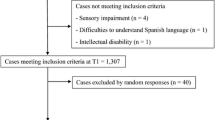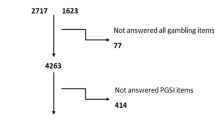Abstract
This study describes the extent and distribution of gambling among Norwegian adolescents. The study assesses whether gambling frequency and expenditures and prevalence of problem gambling are associated both at the individual and aggregate (school) level, and in particular whether the total consumption model applies to gambling behaviour. Data comprised a national representative sample of 11,637 13- to 19-year-old students in 73 schools (response rate 92.3%). The Lie/Bet Questionnaire and an additional DSM-criterion on chasing the losses were applied to assess problem gambling. A majority (78.5%) had gambled during the last year and 3.1% met all three criteria for problem gambling. Gambling frequency and expenditures were much higher among problem gamblers and increased proportionally with the degree of problem gambling. The 6.1% who scored on both Lie/Bet items accounted for 59% of all gambling expenditures on slot machines. Positive and significant correlations between various indicators of problem gambling and the overall amount of gambling at the aggregate (school) level imply that the higher the overall amount of gambling and gambling expenditures are, the higher the prevalence of problem gambling, which indicates that the total consumption model also applies to gambling behaviour among adolescents.


Similar content being viewed by others
References
Abbott, M. (2005). Commentaries. Addiction, 100, 1226–1239.
Abbott, M. W. (2006). Do EGMs and problem gambling go together like a horse and carriage? Gambling Research, 18(1), 7–38.
Australian Productivity Commission (APC) (1999). Australias gambling industries. Report no. 10. Canberra: Ausinfo.
Blaszczynski, A. (2005). Commentaries. Addiction, 100, 1226–1239.
Derevensky, J. L., & Gupta, R. (2000a). Youth gambling: A clinical and research perspective. E-Gambling: The Electronic Journal of Gambling Issue, 2, 1–10.
Derevensky, J. L., & Gupta, R. (2000b). Prevalence estimates of adolescent gambling: A comparison of the SOGS-RA, DSM-IV-J, and the G.A. 20 Questions. Journal of Gambling Studies, 16(2/3), 227–251.
Derevensky, J., Gupta, R., & Winters, K. (2003). Prevalence rates of youth gambling problems: Are the current rates inflated? Journal of Gambling Studies, 19(4), 405–425.
Fisher, S. (1999). A prevalence study of gambling and problem gambling in British adolescents. Addiction Research, 7(6), 509–538.
Gerstein, D., Hoffman, J., Larison, C., Engelman, L., Murphy, S., Palmer, A., Chuchro, L., Toce, M., Johnson, R., Buie, T., & Hill, M. A. (1999). Gambling impact and behaviour study, report to the national gambling impact study commission. Chicago: National Opinion Research Centre at the University of Chicago.
Griffiths, M. D. (1990). The acquisition, development, and maintenance of fruit machine gambling in adolescents. Journal of Gambling Studies, 6, 193–204.
Griffiths, M. D. (1995). Adolescent gambling. London: Routlegde.
Grun, L., & McKeigue, P. (2000). Prevalence of excessive gambling before and after introduction of a national lottery in the United Kingdom: Another example of the single distribution theory. Addiction, 95(6), 959–966.
Gupta, R., & Derevensky, J. L. (1998). Adolescent gambling behaviour: A prevalence study and examination of the correlates associated with problem gambling. Journal of Gambling Studies, 14, 319–343.
Gupta, R., & Derevensky, J. L. (2001). An examination of the differential coping styles of adolescents with gambling problems. Ontario: Report to the Ministry of Health and Long-Term Care.
Götestam, K. G., Johansson, A., Wenzel, H. G., & Simonsen, I. E. (2004). Validation of the Lie/Bet screen for pathological gambling on two normal population data sets. Psychological Reports, 95, 1009–1013.
Hardoon, K. K., & Derevensky, J. L. (2001). Social influences involved in children’s gambling behaviour. Journal of Gambling Studies, 17(3), 191–215.
Hibell, B., Andersson, B., Ahlström, S., Balakireva, O., Bjanrason, T., Kokkevi, A., & Morgan, M. (2000). The 1999 ESPAD report. Alcohol and other drug use among students in 30 European countries. The Swedish Council for Information on alcohol and Other Drugs.
Jacobs D. F. (1989). A general theory of addictions: Rationale for and evidence supporting a new approach for understanding and treating addictive behaviours. In T. N. Cummings (Ed.), Compulsive Gambling: Theory, research & practice. Lexington: Lexington Books.
Jacobs, D. F. (2000). Juvenile gambling in North America: An analysis of long term trends and future prospects. Journal of Gambling Studies, 16(2/3), 119–152.
Jacques, C., Ladouceur, R., & Ferland, F. (2000). Impact of availability on gambling: A longitudinal study. Canadian Journal of Psychiatry, 45, 810–815.
Johnson, E. E., Hamer, R. M., & Nora, R. M. (1988). The Lie/Bet questionnaire for screening pathological gamblers: A follow-up study. Psychological Reports, 83(3 Part 2), 1219–1224.
Johnson, E. E., Hamer, R., Nora, R. M., & Tan, R. (1997) The Lie/Bet questionnaire for screening pathological gamblers. Psychological Reports, 80(1), 83–88.
Ladouceur R., Boudreault N., Jacques C., & Vitaro, F. (1999). Pathological gambling and related problems among adolescents. Journal of Child & Adolescent Substance Abuse, 8(4), 55–68.
Ladouceur, R., Dubè, D., & Bujold, A. (1994). Prevalence of pathological gamblers an related problems among college students in the Quebec metropolitan area. Canadian Journal of Psychiatry, 39, 289–293.
Lemmens, P. (1991). Measurement and distribution of alcohol consumption. Dissertation, Maastrict Netherlands.
Lesieur, H. R., & Blume, S. B. (1987). The South Oaks gambling screen (SOGS): A new instrument for the identification of pathological gamblers. American Journal of Psychiatry, 144, 1184–1188.
Lund, I., & Nordlund, S. (2003). Pengespill og pengespillproblemer I Norge. Rapport nr. 2/2003, SIRUS.
Mäkela, P. (2002). Whose drinking does the liberalization of alcohol policy increase? Change in alcohol consumption by the initial level in the Finnish panel survey in 1968 and 1969. Addiction, 97, 701–706.
National Research Council (1999). Pathological gambling: A critical review. Washington DC: National Academy Press.
O’Connor, J., & Dickerson, M. (2003). Definition and measurement of chasing in off-course betting and gaming machine play. Journal of Gambling Studies, 19(4), 359–386.
Orford, J. F. (2003). Why the British government is wrong to continue to allow juvenile gaming machine playing. Addiction Research and Theory, 11(6), 375–382.
Orford, J. F. (2005a). Disabling the public interest: Gambling strategies and policies for Britain. Addiction, 100, 1219–1225.
Orford, J. F. (2005b). Commentaries. Addiction, 100, 1226–1239.
Raylu, N., & Oei, T. P. S. (2002). Pathological gambling—a comprehensive review. Child Psychology Review, 22, 1009–1061.
Room, R., Turner, N. E., & Ialomiteanu, A. (1999). Community effects of the opening of the Niagara casino. Addiction, 94(10), 1449–1466.
Rose, G. (2001). Sick individuals and sick populations. International Journal of Epidemiology, 30, 427–432.
Rose, G., & Day, S. (1990). The population mean predicts the number of deviant individuals. British Medical Journal, 301, 1031–1034.
Rossow, I. M., & Bø, A. K. (2003). Metoderapport for datainnsamlingen til Ung i Norge 2002. NOVA, Oslo.
Rossow, I., Grøholt, B., & Wichstrøm, L. (2005). Intoxicants and suicidal behavior among adolescents: Changes in levels and associations from 1992 to 2002. Addiction, 100, 79–88.
Rossow, I., & Molde, H. (2006). Chasing the criteria: Comparing SOGS-RA and the Lie/Bet screen to assess prevalence of problem gambling and ‘at-risk’ gambling among adolescents. E-Gambling: The Electronic Journal of Gambling Issue, 18, 57–71.
Shaffer, H. J. (2005). Commentaries. Addiction, 100, 1226–1239.
Shaffer, H. J., & Hall, M. N. (1996). Estimating the prevalence of adolescent gambling disorders: A quantitative synthesis and guide toward standard gambling nomenclature. Journal of Gambling Studies, 12, 193–214.
Shaffer, H. J., & Hall, M. N. (2001). Updating and refining prevalence estimates of disordered gambling behaviour in the United States and Canada. Canadian Journal of Public Health, 92(3), 168–172.
Shaffer, H. J., Hall, M. N., & VanderBilt, J. (1999). Estimating the prevalence of disordered gambling behaviour in the United States and Canada: A research synthesis. American Journal of Public Health, 89(9), 1369–1376.
Shaffer, H. J., LaBrie, R. A. & LaPlante, D. (2004). Laying the foundation for quantifying regional exposure to social phenomena: Considering the case of legalized gambling as a public health toxin. Psychology of Addictive Behavior, 18(1), 40–48.
Skog, O. J. (1979). Modeller for drikkeatferd (Models for drinking behaviour). Oslo: National Institute for Alcohol Research.
Skog, O. J. (1985). Distribution of alcohol consumption, Part III: Evidence of a collective drinking culture. SIFA Mimeograph.
Skog, O. J., & Rossow, I. (2006). Flux and stability: Individual fluctuations, regression towards the mean and collective changes in alcohol consumption. Addiction, 101, 959–970.
Stinchfield, R., Cassuto, N., Winters, K., & Latimer, W. (1997). Prevalence of gambling among Minnesota Public School students in 1992 and 1995. Journal of Gambling Studies, 13, 25–48.
The Norwegian Gaming and Foundation Authority (2006a). Gaming in Norway 2005. Annual Statistic Report. http://www.lotteritilsynet.no
The Norwegian Gaming and Foundation Authority (2006b). Årsmelding 2006. http://www.lottstift.no/dav/01c8632cf2.pdf
The Norwegian Gaming and Foundation Authority (2003). Gaming in Norway 2002. Annual Statistic Report. http://www.lotteritilsynet.no
Turner, N. E., Ialomiteanu, A., & Room, R. (1999). Chequered expectations: Predictors of approval of opening a casino in the Niagara community. Journal of Gambling Studies, 15, 45–70.
Volberg, R. (1993). Gambling and problem gambling among adolescents in Washington State. Report to Washington State Lottery.
Volberg, R. A. (1994). The prevalence and demographics of pathological gamblers: Implications for public health. American Journal of Public Health, 84(2), 237–241.
Volberg, R. A. (1996). Gambling and problem gambling among adolescents in Georgia. Report to the Georgia Department of Human Resources.
Volberg, R. A. (1998). Gambling and problem gambling among adolescents in New York. Report to the New York Council on Problem Gambling.
Volberg, R. A., & Moore, L. (1999). Gambling and problem gambling among adolescents in Washington State: A replication study, 1993 to 1999. Report to the Washington State Lottery.
Volberg, R. A. (2002). Gambling and problem gambling among adolescents in Nevada. Report to the Nevada Department of Human Resources.
Wallish, L. (1993). Gambling in Texas: 1992 Texas survey of adolescent gambling behaviour. Report to the Texas Commission on Alcohol and Drug Abuse.
Welte, J. W., Wieczorek, W. F., Barnes, G. M., Tidwell, M. C., & Hoffman, J. H. (2004). The relationship of ecological and geographic factors to gambling behaviour and pathology. Journal of Gambling Studies, 20(4), 405–423.
Winters, K., Stinchfield, R., & Fulkerson, J. (1993). Toward the development of an adolescent gambling problem severity scale. Journal of Gambling Studies, 9, 371–386.
Williams, R. J., & Wood, R. T. (2004). The proportion of gaming revenue derived from problem gamblers: Examining the issues in a Canadian context. Analyses of Social Issues & Public Policy, 4(1), 1–13.
Acknowledgements
Norwegian Social Research (NOVA) has provided the dataset Young in Norway 2002 in which the analysis are based. The data collection was financed by The Research Council of Norway.
Author information
Authors and Affiliations
Corresponding author
Rights and permissions
About this article
Cite this article
Hansen, M., Rossow, I. Adolescent Gambling and Problem Gambling: Does the Total Consumption Model Apply?. J Gambl Stud 24, 135–149 (2008). https://doi.org/10.1007/s10899-007-9082-4
Received:
Accepted:
Published:
Issue Date:
DOI: https://doi.org/10.1007/s10899-007-9082-4




